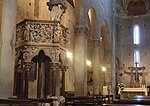Famedio, Pistoia
Buildings and structures in PistoiaMonuments and memorials in TuscanyNeoclassical architecture in Tuscany

The Famedio or Pantheon of Illustrious Men (Pantheon degli Uomini Illustri) is a Neoclassic-style shrine or temple located at the end of a tree lined path, just off Piazza San Francesco #9, in Pistoia, region of Tuscany, Italy. The shrine was envisioned in 1812 as a secular memorial to famous men of Pistoia.
Excerpt from the Wikipedia article Famedio, Pistoia (License: CC BY-SA 3.0, Authors, Images).Famedio, Pistoia
Piazza San Francesco, Pistoia
Geographical coordinates (GPS) Address Nearby Places Show on map
Geographical coordinates (GPS)
| Latitude | Longitude |
|---|---|
| N 43.935803 ° | E 10.910228 ° |
Address
Piazza San Francesco
51100 Pistoia
Tuscany, Italy
Open on Google Maps











